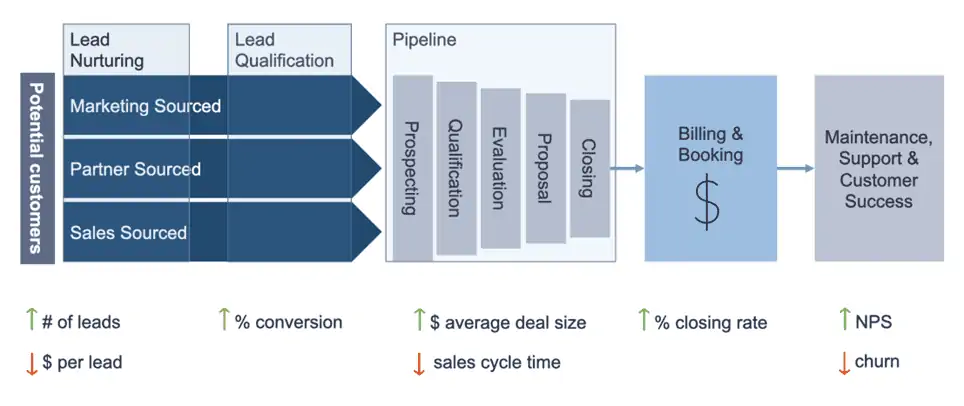Growing your revenue is incredibly hard – when you don’t have the right resources. By resources, I mean tools, processes, and even knowledge. I’ve seen companies with great products and teams fizzle out of business because they lack a thorough understanding of something as simple as how their end-to-end revenue generation process works. And needless to say, this is one of the fastest ways to cause leaks in your revenue engine. This is why I started this blog series titled “Optimal Revenue Generation Process”.
At this point, you’re probably wondering, “why should I listen to this guy?” Well, my name is Anton Antich, and I have years of experience in helping businesses grow revenue by optimizing their internal processes. I have done this at Veeam Software as the SVP of Strategic Operations where I grew the company’s revenue from 0 to over one billion in just 10 years. Over the years, I have continued to perfect this approach while working with about twenty startups. I have also invested in several businesses as an Angel investor.
This blog post is the first of many parts in the “Optimal Revenue Generation Process” series. In this introductory post, I will walk you through the basics of the revenue generation process and how to optimize it at every stage to double your revenue. The successive parts of this series will dive deeper, detailing the systematic ways to grow your revenue by optimizing your internal processes. So, let’s get into it.
What is the End-to-End Revenue Generation Process?
In the simplest sense, the revenue generation process consists of all the activities that help a company generate revenue or profit. It is all the business processes and tools within your organization that work towards the primary purpose of generating revenue. It typically follows these steps:
- Capturing leads acquired via three main channels – sales (e.g., via proactive sales outreach activities or networking), marketing (via all the lead generation toolboxes available today), and partners (essential for many businesses and often underestimated)
- Lead nurturing activities
- Lead qualification step where a lead either turns into a sales opportunity or is returned to the lead nurturing engine
- Sales pipeline with your customized and defined sales process
- Billing and booking (often called “quote to cash”)
- Maintenance, support, “customer success,” and expansions
While this process may slightly vary from one organization to another, the most important thing is how they manage this process end-to-end, with constant optimization and fine-tuning. In contrast, a more common approach is siloed, with inefficiencies and conflicts between departments.
A deeper dive into the revenue generation process
A more critical examination of a typical revenue generation process will most likely show that there is a very limited number of top-level KPIs you need to worry about, all of which contribute to your final revenue results. These include:
- Number of leads and cost per lead
- Conversion % from leads to sales opportunities
- Average deal size and sales cycle time
- Closing % from opportunities to booked deals
- Churn and net promoter score
Join the revenue club
The primary job of the revenue operations VP or director is to constantly monitor these KPIs and lead the process optimization activity within the company with other stakeholders. This is extremely important and often underestimated. Here’s a quick illustration depicting why this is important.
With ten thousand leads generated monthly, 20% conversion into opportunities, a 10,000 USD average deal size, and a 25% closing rate, this process would generate approximately 60 million USD annually. What if we focus on optimizing this process to generate small profits in each of the areas, as pictured below?
With a relatively modest increase in only 4 out of 8 KPIs – 20% more leads monthly, increased qualification procedure, some better pricing policy that leads to the average deal size increase, and better focus on closing deals to get the closing rate to 30% from 25% – how much do you think the total annual bookings will be?
The answer is – approximately $155 million. That is more than a 2.5x increase from the $60M we saw in the initial example. So, what has this example shown us? That your revenue is likely leaking at each stage of this process, even right now as you read this article.
Fixing the leaks: magic or math?
So, to the big question; “how did we fix the leaks?” Well, it’s not magic; it’s pure math and an understanding of how to optimize the revenue generation process. Imagine if you, as a revenue operations or sales leader, could bring such improvements to your company and stop this leakage. That would be amazing, right? But, the reality is, that not many companies diligently focus on improving this end-to-end revenue generation process daily.
An excellent way to stop revenue leaks and easily optimize your revenue generation process for growth is by investing in a revenue intelligence solution like Revenue Grid. With a tool like Revenue Grid, it is relatively easier to spot leaks ahead of time, and quickly plug them so your growth and profits are not affected at any stage in the revenue generation process.
It is potentially one of the biggest opportunities for growth that your company might be missing right now. So, if you’re curious about how to set up this process based on the best practices from experts around the world, and how to look for and implement those small efficiency gains for each of the KPIs and stages, then stay tuned for the succeeding parts of this article.






